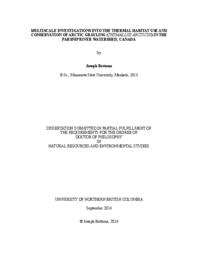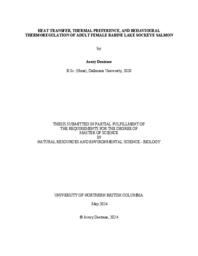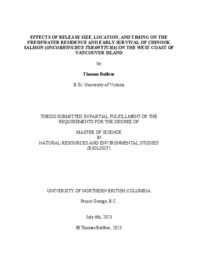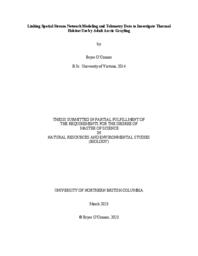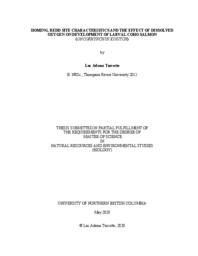Martins, Eduardo
Person Preferred Name
Eduardo Martins
Related Works
Content type
Digital Document
Origin Information
Content type
Digital Document
Origin Information
Content type
Digital Document
Origin Information
Content type
Digital Document
Origin Information
Content type
Digital Document
Origin Information
Content type
Digital Document
Description / Synopsis
Hatchery enhancement of declining Pacific salmon populations has long been a foundation of salmon management; however, the influence of hatchery release practices on freshwater residence time and survival to estuarine entry is not well-understood. This study employed Passive Integrated Transponder (PIT) tags to evaluate the relationships between the size of individuals at release, release location, and release timing on the duration of freshwater residence and survival of hatchery-produced Chinook salmon (Oncorhynchus tshawytscha) in the 103 km2 Toquaht River watershed, located on the west coast of Vancouver Island, British Columbia. The Toquaht River mainstem is ~22 km in length, divided into upper and lower sections by the 118 ha Toquaht Lake. A total of 4848 PIT-tagged Chinook salmon smolts were released on three dates (May 23rd, June 9th, June 19th), and during each release, fish were split evenly between three different locations within the watershed (Toquaht Lake: 7.9 km from the detection array; upper river: 11.9 km from the array; and the lower river: 4.1 km from the array). The detection data were analyzed using an integrated model of freshwater residence and capture–recapture fitted using Bayesian inference. The duration of freshwater residence between release and detection ranged from 0.5–60 days, with a mean of 14 days, and exhibited a negative relationship with fish size. The estimated median survival probability for all locations and dates was 0.39, with the highest probability of survival (0.78) found in fish released into the lake on June 19th and the lowest (0.06) for lower-river fish released on June 9th. Changes in streamflow were likely responsible for the observed pattern in survival by date. Survival probability decreased as fish size increased. Overall, the study provides further evidence that hatchery release strategies can significantly influence freshwater residence and survival, and these practices should be well-understood and flexible in the face of changing environmental conditions. The results of this study may have significant implications for the management of Toquaht River Chinook salmon, particularly in the context of ongoing efforts to rebuild the naturally spawning population.
Origin Information
Content type
Digital Document
Description / Synopsis
River networks have a high amount of thermal habitat heterogeneity which is a critical abiotic factor driving freshwater fish distribution. The fitness repercussions of residing outside a species’ optimal thermal limits, and the resulting behavioural responses to stress, restrict the amount of freshwater habitat available to ectothermic organisms. Changes in ectotherm distribution due to climate-related shifts in thermal habitat availability have been well documented and have been especially pronounced at distributional limits. My objective was to characterize variations in the availability of thermal habitat and quantify its influence on the distribution of a cold-water adapted aquatic ectotherm, Arctic grayling in the Parsnip River watershed in northern British Columbia. The presence of a thermal gradient in the watershed was revealed by a spatial stream network model and its influence on adult Arctic grayling summer distributions was explored with a dynamic site occupancy model using acoustic telemetry data. Results suggest a high probability of occupancy (> 0.75) at temperatures ranging from 8.7-14.2ºC with a peak at 10.9ºC. The distribution of thermal habitat within this range was limiting in only one of the three years during the study period. In 2021 the distribution of thermal habitat with a high probability of use during the study period was reduced to 57% of the accessible watershed length from 89% in 2019 and 87% in 2020. Small streams in high elevation tributaries (e.g., >800 m) are important cold-water sources for Arctic grayling refugia under warm conditions. Increased habitat protections for high elevation streams should be prioritized to ensure a future for cold-water adapted species in the Parsnip River watershed.
Origin Information
Content type
Digital Document
Description / Synopsis
Advancements in animal tracking technology and analytical techniques have expanded the disciple of movement ecology. An improved understanding of where, when, and why an animal moves can greatly assist in the management and recovery of endangered species. White sturgeon (Acipenser transmontanus) in the Upper Columbia River (UCR) are listed as Endangered due to their considerable decline over the last century. Habitat fragmentation, caused by the construction of dams for hydroelectric generation and river regulation, has greatly impacted white sturgeon populations by preventing access to critical habitat, impacting water quality, and modifying natural flow regimes. The goal of this study was to apply more advanced analytical techniques to white sturgeon movement datasets from a regulated and transboundary reach of the UCR, so as to further understand white sturgeon movement and behaviour in relation to river regulation. Using hidden Markov models (HMMs) and generalized linear mixed models (GLMMs), this study investigated the fine-scale movements of wild adult white sturgeon residing immediately downstream of a hydroelectric operation and the coarse-scale movements of hatchery-origin white sturgeon residing throughout the Transboundary Reach of the UCR. In my fine-scale dataset, two behaviour states were identified: a “residential” behaviour representing short movements with persistent direction, and a “transitory” behaviour representing longer movements with frequent turns. Results revealed that white sturgeon were very likely to remain in a behaviour state, with environmental covariates influencing the probability of a behaviour state only when there was less certainty of the state in the previous timestep (i.e. probability of 50%). Overall, water temperature appeared to influence what behaviour state was more predominantly expressed while discharge appeared to influence where each behaviour state was expressed. Warming water temperatures related to decreased probabilities of residential behaviour and changes in discharge shifted the location of residential behaviour within eddy and tailrace habitats. In my coarse-scale dataset, two behaviour states were also identified: a similar “residential” behaviour state representing localized movement at a single receiver station, and a “transitory” state representing movements between receiver stations. Overall, hatchery-origin white sturgeon moved very little and demonstrated strong site fidelity. When fish did move, location (i.e. country, river zone), discharge, and water temperature had the greatest influence on maximum displacement and behaviour probability. Increases in discharge related to faster declines in maximum displacement in Canada compared to the United States, as well as fish in more channelized river zones having increased probabilities of residential behaviour when previously in a transitory state. Warming water temperatures related to increases in maximum displacement and decreases in the probability of residential behaviour (when previously in a transitory state). In both fine-scale and coarse-scale datasets, trends could be observed seasonally, with increased movement in the summer and fall compared to the winter and spring. Results from this study better described white sturgeon interactions with dams, help describe the effectiveness of recovery measures like conservation aquaculture, and inform management decisions related to river regulation.
Origin Information
Content type
Digital Document
Description / Synopsis
Life histories of Pacific salmon are remarkable in that they return to specific freshwater sites to spawn after multiple years of ocean residence. In Chapter 1, I investigated site fidelity at a reach scale for Interior Fraser Coho Salmon (Oncorhynchus kisutch) (IFC). Coho Salmon eggs were incubated at known spawning locations in the Coldwater River, British Columbia, to obtain reference data for comparison to otolith signatures of returning adult salmon. The majority of adults (67%) returned to their natal spawning locations at the reach scale, while 33% strayed to other spawning sites within the Coldwater River, illustrating straying at small scales. Straying to novel incubation sites at the reach scale demonstrated plasticity in homing within a watershed. In Chapter 2, I investigated the characteristics of the hyporheic redd zone over two years where Coho Salmon were observed to spawn. Within a reach, physical variables were homogenous, but heterogeneity was found among reaches where Coho Salmon were observed to spawn – particularly for intragravel temperature and dissolved oxygen. The difference in temperature and dissolved oxygen among sites had a pronounced effect on survival, rate of development, and emergence time for Coho Salmon fry. Heterogeneity among spawning locations demonstrate trade-offs that exist between rate of development and survival. Chapter 3 investigated the effect of low and variable dissolved oxygen on developing salmon embryos. A family effect was found as smaller eggs produced smaller alevin, but the effect of low dissolved oxygen on growth was also greater for the families with small eggs. Treatment affected rate of development and initially had an effect on length and mass, but by button-up there was no longer an effect of low dissolved oxygen on size. My work demonstrates plasticity in Coho Salmon at different life stages. Plasticity is important for utilizing new habitats or adapting to existing habitats as they change.
Origin Information



